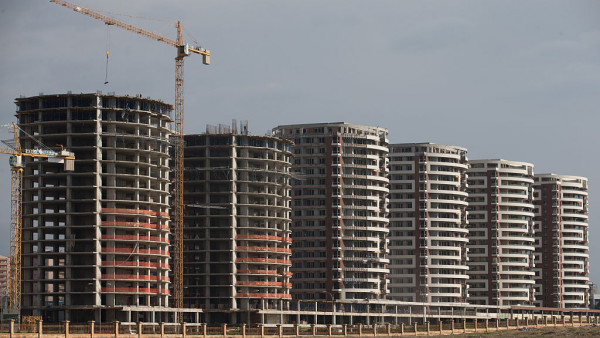The Iraqi government is working to establish a number of new residential mega-cities in different areas across the country as part of a plan to ease the acute housing crisis gripping the country.
Densely overpopulated neighbourhoods and cities are just one of many complex crises Iraq has been afflicted with for decades, a problem compounded by a severe housing shortage which successive governments have failed to address.
While Iraqi Prime Minister Mohammed Shia Al-Sudani has stated that Iraq requires around three million housing units, the government’s current plans aim to oversee the construction of around 300,000, which will include homes for low and middle-income families as a first step.
There is optimism around the current plans and hopes that the government’s strategy will successfully alleviate the severe overcrowding plaguing many residential areas in Iraq.
However, promises by previous governments to solve the crisis have failed to materialise, and the sector is acknowledged to have been plagued by corruption for many years.
A solution to the housing crisis
The current Iraqi government pledged several months ago that it planned to construct new residential cities on the outskirts of the capital Baghdad as a solution to the crisis. In line with these plans, the parliament has agreed to award construction contracts for the first five of the new cities to specialist companies, both local and foreign.
For one of the new residential “cities”, Al Jawahiri, which will be located on the outskirts of Baghdad and which is planned to include 30,000 housing units, construction contracts were awarded in late 2023 to Chinese firms East China Engineering Science and Technology Co., Ltd and China National Chemical Engineering Co., Ltd, alongside Iraqi firm Shams al-Binaa.
Salar Mohammed Ameen, vice chairman of the National of Investment Commission, said the cost for Al Jawahiri’s construction was estimated at $2 billion, none of which would be financed by the Iraqi government, and that it was expected to be finished in four to five years.
The four other cities planned to form the first phase of the mega development project are Al-Ghazlani in Nineveh – for which the building contract has also been awarded to a Chinese firm and its partners – New Fallujah in Anbar, Al-Janain in Babylon, and Difaf in Karbala. Preliminary work has already started on these cities, which are set to provide hundreds of thousands of housing units.
At the end of June, the government gave a green light to construction work on the road that will lead to the new residential mega-city of Ali Al-Wardi, situated 25km south of Baghdad.
Named after the late Iraqi sociologist and thinker Ali Al-Wardi, it will be the largest of the new cities and covers an area of 61 million sqm. Planned to provide over 100,000 housing units of varying kinds, as well as urban facilities, green spaces, and smart technology, the contract for its construction was awarded to Egypt’s ORA Developers earlier this year.
Advanced standards in sustainability and environmental protection are planned to be incorporated into its construction.
The new mega-cities construction project being rolled out is the biggest in Iraq’s history, and is largely being funded by foreign investment, with the Iraqi government having presented the country’s housing sector as one of the country’s lucrative investment opportunities for foreign developers.
Overcrowding in Iraq
Engineer Haidar Al-Khafaji who is working for the New Cities Implementation Authority (NCIA) within the Ministry of Construction, Housing and Public Municipalities, says the “residential cities projects will, to a large extent, end the housing crisis, especially in the capital Baghdad”.
He explained to Al-Araby Al-Jadeed, The New Arab’s Arabic-language sister edition, that “studies and statistics indicate that overcrowding in Baghdad will reach up to 11 million people, a dangerous number, which has pushed the government to enact the necessary plans to avoid [this]”.
“The continuous neglect of the housing issue by former governments has led to the massive population overcrowding,” says Khafaji, adding that “the two cities, Ali Al-Wardi and Al Jawahiri on Baghdad’s outskirts will be fully serviced cities, with long-term strategic planning taking into consideration, especially with regards to the location, which will ease the population pressure in the heart of the capital”.
He says around 200,000 housing units will be created in these two new cities, within a broader strategy laid out by the government which involves the establishment of 52 sustainable residential complexes and cities in the central and southern regions of Iraq.
He believes the strategy provides the best solution to population overcrowding in Iraq.
Official Iraqi government statistics confirm that nine percent of the population live in “ashwaa’iyaat” (slums built unofficially and not in accordance with building regulations on state land), because inhabitants have been unable to afford appropriate housing.
While the last government launched the project “Dari” (“my house”), to grant the unemployed plots of land and support to build their own homes, the project was never actually implemented, even though thousands of Iraqis applied to the scheme and consulted the relevant state departments in order to obtain a plot.
Beginning implementation
In June, Iraqi prime minister Al-Sudani launched the start of construction for the road to Ali Al-Wardi. According to a press statement issued by the PM’s office, the work on the road would stretch from Baghdad’s outskirts to the new city in the Nahrawan district, southeast of Baghdad.
“The work will include constructing a road to the new city that meets the best design requirements and will ensure the smooth flow of traffic into the new city by linking it to the main and ring roads.”
The statement confirmed that these new residential cities formed the basis for the solution the government had adopted to combat the rising population and ease the pressure on services and electricity in Baghdad, and as part of improving movement, transport, and development in the capital.
“Ali Al-Wardi city won’t be a residential complex, but a major new city with integrated services and facilities, which will include around 110,000 housing units. It will, with its surroundings, constitute the core of what could be termed a new governorate, in terms of capacity. It will be adjacent to Baghdad and be complementary to it,” read the statement.
Aktham Saif al-Din, an Iraqi journalist, wrote in 2017 about the corruption plaguing housing construction and development projects in Iraq.
The rise in Iraq’s population, the lack of will in consecutive governments, the steep rise in building materials, poor planning, and deep issues of corruption had all played a role in Iraq’s severe housing crisis, the article outlined.
Economist Ahmad Al-Kanani was quoted as saying that the five Iraqi governments which had served since the 2003 US-led invasion toppled the Baathist government were all responsible for the crisis and that corruption was ravaging the housing sector, both governmental and by investors, adding that “no less than 9 billion dollars during Nouri al-Maliki’s government was allocated to housing, but Iraqis saw no housing project on the ground at that time”.
Sudani, then an MP, was quoted at the time emphasising the issue of corruption in housing development projects and stating that the Iraqi parliament held “the monitoring role which qualifies it to hold officials complicit in [corrupt] files accountable”.
This is an edited translation from our Arabic edition with additional reporting. To read the original article click here.
Translated by Rose Chacko
This article is taken from our Arabic sister publication, Al-Araby Al Jadeed and mirrors the source’s original editorial guidelines and reporting policies. Any requests for correction or comment will be forwarded to the original authors and editors.
Have questions or comments? Email us at: info@alaraby.co.uk


